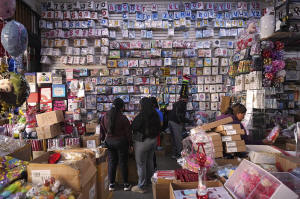Trump's massive import taxes haven't done much economic damage -- yet
[May 19, 2025] By
PAUL WISEMAN, CHRISTOPHER RUGABER and ANNE D'INNOCENZIO
WASHINGTON (AP) — For months, American consumers and businesses have
been hearing that President Trump’s massive import taxes – tariffs –
would drive up prices and hurt the U.S. economy. But the latest economic
reports don’t match the doom and gloom: Inflation actually eased last
month, and hiring was solid in April.
For now, the disconnect has businesses and consumers struggling to
reconcile what they were told to expect, what the numbers say and what
they are seeing on the ground. Trump and his supporters are quick to
point out that the trade wars of his first term didn’t translate into
higher overall inflation across the economy.
So is it time to breathe easy? Not yet, economists say. Trump’s tariffs
are still huge – the highest since the Great Depression of the 1930s.
They’re unpredictable: The president frequently announces tariffs only
to suspend them days later and to conjure up new ones. And they are
still working their way through the system.
“We had a good jobs report. We had a cool inflation report, and that’s
great,” said Ernie Tedeschi, director of economics at Yale University’s
Budget Lab. “But that should not give us comfort about what next month
will be, particularly on inflation.’’
Walmart, for example, warned its customers last week that prices will be
going up for everything from clothing to car seats. Prices for some
items like bananas have already increased.
True, the truce with China last Monday dramatically reduced the risks to
the U.S. economy, and U.S. and global stock markets rallied last week in
relief. The United States dropped the import tax that Trump angrily
imposed on China – America’s third-biggest source of imports – from an
eye-watering 145% to 30%; Beijing cut its retaliatory tariffs from 125%
to 10%. Economists at JPMorgan Chase, who had forecast last month that
the China tariffs made a recession likely, don’t expect one now.

Trump's tariffs are the highest since the Great Depression
But even with the lower levies on China, the Yale Budget Lab reported
that the cost of Trump’s trade war will be high. Climbing prices will
reduce the purchasing power of the average household by $2,800. Shoe
prices will rise 15% and clothing 14%. The tariffs will shave 0.7
percentage points off U.S. economic growth this year and increase the
unemployment rate — now a low 4.2% — by nearly 0.4 percentage points.
Trump has plastered 10% taxes on imports from almost every country on
earth. He’s also imposed 25% duties on cars, aluminum, steel, and many
imports from Canada and Mexico.
The Yale Budget Lab estimates that Trump policies will push the average
U.S. tariff rate to 17.8%, highest since 1934 and up from around 2.5%
when Trump took office. (Other economists put his tariff rate at 14% to
15%.) During Trump’s first term, the average tariff rose just 1
percentage point despite all the headlines generated by trade policies.
Now, according to the budget lab, they are rising 15 percentage points.
And the tariffs have only begun to bite. In April, the import tax
revenues collected by U.S. Customs and Border Protection came to a
tariff rate of just 4.5%, a fraction of what’s coming, Tedeschi said.
That’s partly because of delays in rolling out the tariffs, including
technical glitches that prevented customs agents from collecting them
for a couple of weeks.
The full impact has also been delayed because companies beat the clock
by bringing in foreign goods before Trump’s tariffs took effect.
Retailers and importers had also largely halted shipments of shoes,
clothes, toys, and other items due to new tariffs, but many are resuming
imports from China.
Tedeschi, who was chief economist at President Joe Biden’s Council of
Economic Advisers, also notes that it just takes time for tariffs to
translate into higher prices. During Trump’s first term, his January
2018 levies on foreign washing machines didn’t yield more expensive
appliances until April that year. Still, a Federal Reserve study this
month found that duties Trump imposed in 2018 and 2019 meant higher
prices as soon as two months later, suggesting consumers could start
paying more in June.

[to top of second column] |

People shop at a party supply store in the Toy District of Los
Angeles on April 9, 2025, where the majority of items are imported
from China. (AP Photo/Jae C. Hong, File)
 Consumers are less willing to
accept higher prices
Things have changed from the first time Trump was in the White
House. During his first term, companies essentially passed along the
entire cost of his tariffs. Now American consumers, still scarred by
the burst of inflation that followed the COVID-19 pandemic, may be
more reluctant to accept higher prices.
“Consumers weren’t inflation exhausted in 2018 the way that they are
now,’’ Tedeschi said. Surveys by Federal Reserve banks in Atlanta
and Dallas have found that most companies would eat at least some of
the tariff costs this time around. And one reason that the Labor
Department’s producer price index fell in April was that retailers
and wholesalers reported lower profit margins, a sign that they may
have been absorbing some of the tariff cost.
The economic damage doesn’t just come from the cost of tariffs, but
from the erratic way the president imposes them. For instance, the
145% China tariffs were just suspended for 90 days. Likewise, Trump
has paused high taxes he slapped last month on imports from
countries with which the United States runs trade deficits. Could
those levies come back?
Consumers are clearly fearful that the duties will boost prices, as
consumer confidence surveys have plummeted since Trump began ramping
up his tariff threats in February. The Conference Board’s consumer
confidence index has fallen for five straight months to its lowest
level since the depths of the pandemic in May 2020.
Costlier coffee and Christmas wreathes are coming
Snowy Owl Coffee Roasters in Sandwich, Massachusetts, which imports
beans from Brazil, Nicaragua, Burundi and other countries, is only
now planning to raise its prices this week to cover the cost of the
10% tariffs. It plans to add 25 cents to 35 cents to the price for
each cup.
“Tariffs are increasing costs and they’re adding to a lot of
uncertainty around the potential for a downturn,” said Shayna
Ferullo, 44, co-owner of Snowy Owl. “We are looking closely at the
year ahead with the goal of consolidating and operating really,
really tightly.”
Ferullo will also have to pay much more than she budgeted to
renovate her shop in Brewster, Massachusetts -- one of her three
retail locations -- because the contractor has raised his estimate,
partly due to tariffs on building supplies. She has already elected
to not fill one job after an employee left and is looking at ways
automation could help reduce her labor costs, though she hasn’t laid
off any of her 35 employees.

Jared Hendricks, CEO of Village Lighting Co., last month halted
shipments of supplies he gets from China – holiday storage bags,
wreathes, holiday lights and garlands. Now that the U.S. and China
have reached a truce, he’s trying to get the products to the United
States in time for the holidays.
He estimates that it will take 10 to 20 days from China to the West
Coast ports via ship and another 20 days to 40 days for the goods to
go through U.S. Customs, then travel via Union Pacific Railways to
his company in Utah. Given all the expected delays, Hendricks said
he’s worried that his holiday décor won’t arrive by Sept. 1 when it
should start appearing in stores.
Meanwhile, he’s figuring out how to foot a $1 million bill for the
tariffs. He’s hoping he can cover the cost by raising prices 10% to
15%.
In the meantime, he’s trying to secure a loan against his house to
pay for the levies.
“We are moving forward,’’ he said, “but at great cost, personal
risk, and weariness.”
____
D'Innocenzio reported from New York.
All contents © copyright 2025 Associated Press. All rights reserved |